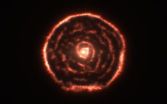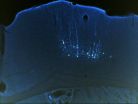(Press-News.org) Single fatherhood is a challenge many arachnids undertake, guarding eggs laid by females despite the costs to their own health and mating benefits, but the news may not be all bad for these dads.
New research now shows that, in one species of spiders, males exclusively responsible for guarding eggs actually enjoy survival benefits rather than suffer losses to health or mating privileges. The study, published Oct. 10 in the open access journal PLOS ONE by Gustavo Santos Requena and colleagues from the University of Sao Paulo, Brazil, evaluates the costs and benefits of exclusive paternal care, the rarest form of parental investment in nature, in the harvestman spider Iporangaia pustulosa.
The researchers tracked spiders in the forests of southeastern Brazil over the course of a year to observe how caring behavior in males affected their chances of survival or body condition. Though caring males feed very rarely and lose body condition while guarding eggs, the authors found that these spiders suffered no long-term decrease in fitness compared to females or non-caring males. Their sedentary behavior during the caring period also makes them less likely to be eaten by predators, reducing their mortality risk. The authors also suggest that providing females cost-free care for their offspring might make caring males more attractive to females, thereby improving their chances for reproductive success.
According to the authors, their results suggest that the reduction in mortality risk, combined with the genetic advantages of improving survival of their offspring, may have played important roles in favoring the evolution of paternal care in insects.
INFORMATION:
Citation: Requena GS, Buzatto BA, Martins EG, Machado G (2012) Paternal Care Decreases Foraging Activity and Body Condition, but Does Not Impose Survival Costs to Caring Males in a Neotropical Arachnid. PLoS ONE 7(10): e46701. doi:10.1371/journal.pone.0046701
Financial disclosure: The study was supported by fellowships from Fundação de Amparo à Pesquisa do Estado de São Paulo (FAPESP, process number: 02/00381-0, 03/05418-1, 08/54833-5, and 08/50466-8) and Coordenação de Aperfeiçoamento de Pessoal de Nível Superior. The funders had no role in study design, data collection and analysis, decision to publish, or preparation of the manuscript.
Competing Interest Statement: The authors have declared that no competing interests exist.
PLEASE LINK TO THE SCIENTIFIC ARTICLE IN ONLINE VERSIONS OF YOUR REPORT (URL goes live after the embargo ends):
http://dx.plos.org/10.1371/journal.pone.0046701
Single spider dads caring for eggs suffer no disadvantages despite parenting costs
2012-10-11
ELSE PRESS RELEASES FROM THIS DATE:
Skin hair skims heat off elephants
2012-10-11
Body hair in mammals is typically thought to have evolved to keep us warm in colder prehistoric times, but a new study suggests that it may do the opposite, at least in elephants. Epidermal hair may have evolved to help the animals keep cool in the hot regions they live in, according to new research published Oct 10 in the open access journal PLOS ONE by Conor Myhrvold and colleagues at Princeton University.
Though the idea that low surface densities of hair can help dissipate heat is a popular concept in engineering, the biological and evolutionary significance of sparse ...
Parent-clinician communication about children's drug reactions needs improvement
2012-10-11
Many parents are dissatisfied with communication regarding adverse drug reactions experienced by their child, and the implications of such reactions for the child's future use of medicines, according to a new study published Oct. 10 in the open access journal PLOS ONE by Bridget Young from the University of Liverpool, UK and colleagues.
The researchers interviewed parents of 44 children who had a suspected adverse drug reaction for their study. They found that the majority of parents in their study were dissatisfied with the clarity and timing of communications from ...
Like songbirds and people, mice can learn new tunes
2012-10-11
AUDIO:
This is a mouse song.
Click here for more information.
Scientists have found the first evidence that the ability to learn vocalizations, a capacity so far believed to be restricted to a handful of bird and mammal species like humans and dolphins, is shared by another species: mice. The new research, published Oct. 10 in the open access journal PLOS ONE by Erich Jarvis and Gustavo Arriaga at Duke University and colleagues, shows for the first time that mice share certain ...
Negative news stories affect women's stress levels but not men's
2012-10-11
Bad news articles in the media increase women's sensitivity to stressful situations, but do not have a similar effect on men, according to a study undertaken by University of Montreal researchers at the Centre for Studies on Human Stress of Louis-H. Lafontaine Hospital. The findings were published today in PLOS One. The women who participated in the study also had a clearer recollection of the information they had learned. "It's difficult to avoid the news, considering the multitude of news sources out there, said lead author Marie-France Marin. "And what if all that news ...
Cambrian fossil pushes back evolution of complex brains
2012-10-11
The remarkably well-preserved fossil of an extinct arthropod shows that anatomically complex brains evolved earlier than previously thought and have changed little over the course of evolution. According to University of Arizona neurobiologist Nicholas Strausfeld, who co-authored the study describing the specimen, the fossil is the earliest known to show a brain.
The discovery will be published in the Oct. 11 issue of the journal Nature.
Embedded in mudstones deposited during the Cambrian period 520 million years ago in what today is the Yunnan Province in China, the ...
NIH researchers provide detailed view of brain protein structure
2012-10-11
Researchers have published the first highly detailed description of how neurotensin, a neuropeptide hormone which modulates nerve cell activity in the brain, interacts with its receptor. Their results suggest that neuropeptide hormones use a novel binding mechanism to activate a class of receptors called G-protein coupled receptors (GPCRs).
"The knowledge of how the peptide binds to its receptor should help scientists design better drugs," said Dr. Reinhard Grisshammer, a scientist at the NIH's National Institute of Neurological Disorders and Stroke (NINDS) and an ...
Glaciers cracking in the presence of carbon dioxide
2012-10-11
The well-documented presence of excessive levels of carbon dioxide (CO2) in our atmosphere is causing global temperatures to rise and glaciers and ice caps to melt.
New research, published today, 11 October, in IOP Publishing's Journal of Physics D: Applied Physics, has shown that CO2 molecules may be having a more direct impact on the ice that covers our planet.
Researchers from the Massachusetts Institute for Technology have shown that the material strength and fracture toughness of ice are decreased significantly under increasing concentrations of CO2 molecules, ...
Close call – bad weather drives up phone calls to our nearest and dearest
2012-10-11
Who we call and how long we speak to them changes with the weather, according to new research by experts at Newcastle University.
Analysing the call patterns of 1.3 million mobile phone users, the team found that in 'uncomfortable' weather – such as very hot, humid, wet or cold weather – call length increased but the number of people we made contact with went down.
Apparently "isolating" ourselves during more unpleasant weather, research lead Dr Santi Phithakkitnukoon said the data showed that we were also more likely to contact our close friends and family than our wider ...
Surprising spiral structure spotted by ALMA
2012-10-11
A team using the Atacama Large Millimeter/submillimeter Array (ALMA), the most powerful millimetre/submillimetre telescope in the world, has discovered a surprising spiral structure in the gas around the red giant star R Sculptoris [1][2][3]. This means that there is probably a previously unseen companion star orbiting the star [4]. The astronomers were also surprised to find that far more material than expected had been ejected by the red giant.
"We've seen shells around this kind of star before, but this is the first time we've ever seen a spiral of material coming ...
Singing mice show signs of learning
2012-10-11
DURHAM, N.C. -- Guys who imitate Luciano Pavarotti or Justin Bieber to get the girls aren't alone. Male mice may do a similar trick, matching the pitch of other males' ultrasonic serenades. The mice also have certain brain features, somewhat similar to humans and song-learning birds, which they may use to change their sounds, according to a new study.
"We are claiming that mice have limited versions of the brain and behavior traits for vocal learning that are found in humans for learning speech and in birds for learning song," said Duke neurobiologist Erich Jarvis, who ...




